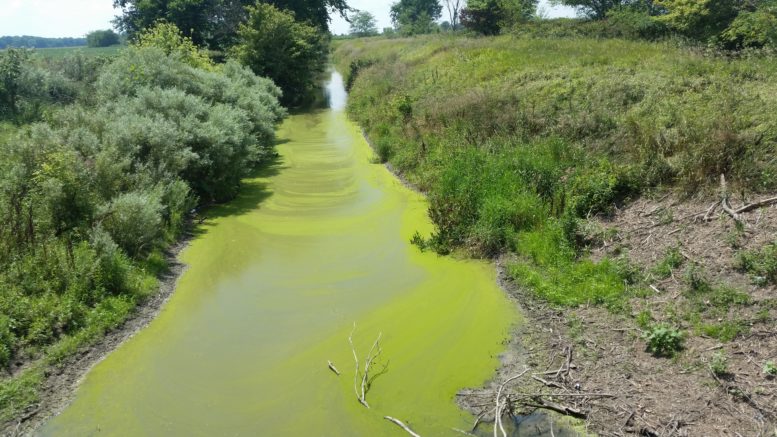By JAN LARSON McLAUGHLIN
BG Independent News
Wood County Commissioners were asked this year by an environmentalist to sign onto a request that Lake Erie’s Western Basin be declared “impaired.” They were also asked this year by a farmer to not seek the “impaired” designation.
Not certain of the best course of action, the commissioners asked the Ohio Environmental Protection Agency to help clear up the issue. But the issue seemed to get more complicated instead.
“As clear as mud,” Karl Gebhardt said as he left the commissioners’ office on Tuesday.
Gebhardt, deputy director of the Ohio EPA Water Resources and Lake Erie Programs and executive director of the Ohio Lake Erie Commission, said the phosphorus causing algae problems in the lake is already being worked on by the state – and federal involvement is not needed.
Ohio EPA officials hear the complaints: “Why is Lake Erie green? Why can’t my grandchildren go swimming in the lake?” But efforts are already underway, Gebhardt said.
Based on the marine life in the lake, the shoreline of Lake Erie has already been declared “impaired.” And based on the water treatment steps needed, the areas of Lake Erie around water intakes have been declared “impaired.”

Karl Gebhardt, of the Ohio EPA, talks about Lake Erie.
The U.S. EPA would like Ohio to designate the Western Lake Erie Basin as impaired, Gebhardt said. But there is currently no science-based criteria for that designation. “We really want to base this on science,” he told the county commissioners.
Ohio EPA officials have asked the U.S. EPA to establish “impaired” criteria for open waters. But so far, that has not been done. “We’re saying it’s multi-jurisdictional,” but the U.S. EPA wants each state to set standards, Gebhardt said. “We don’t feel it’s right to establish criteria that is just for Ohio.”
“We have to look at the entire lake and not just Ohio’s portion,” he said.
Gebhardt’s other concerns about labeling the lake as “impaired” are that “tag” stays with the lake for at least two years and there is no defined process to get rid of that label.
“Do we really want the headlines and do we really want people to think it’s always impaired,” he asked. “We just want to be careful that we don’t put a tag on the lake that’s not warranted.”
Gebhardt said Ohio EPA and the Ohio Lake Erie Commission already have a plan in place to limit the phosphorus creating algae in the lake.
“We don’t really need the feds coming in and putting more regs on us,” he said.
The U.S. EPA would require the region to identify sources of phosphorus and address the problem. “We’re already doing that.”
An existing Great Lakes Water Quality Agreement with Canada has set the scientific standard that phosphorus entering the lake be reduced by 40 percent. That means Canada’s portion must be reduced by 300 metric tons, while the U.S. portion must drop by 2,300 metric tons.
Originally, the plan was to start the reduction efforts in 2018. But Gov. John Kasich and Ohio EPA Director Craig Butler decided that was not soon enough. The plan looks at the primary sources, such as agriculture, septic systems and stormwater.
“Everyone has a piece of this issue,” Gebhardt said.
The Maumee River is the biggest contributor to the phosphorus levels in the lake, Gebhardt said. “The Maumee River serves basically as a conduit.”
The river is designated as impaired due to nitrate levels. But since the river moves fast enough to not have algae issues, it has not been labeled as impaired due to phosphorus.
“If we know the Maumee is the greatest contributor to phosphorus in the lake,” yet it is not labeled as impaired, “doesn’t that show we’re not doing our job?” Wood County Commissioner Joel Kuhlman asked.
But Gebhardt said the Ohio EPA is monitoring wastewater systems, the Ohio Department of Agriculture is working with the farming communities, and the Ohio Department of Health is working to get rid of faulty home septic systems.
Efforts need to be tracked as they go, he said. “We don’t want farmers doing conservation practices, spending the money, if it isn’t working,” Gebhardt said.
“We have to be able to change the approach we use based on science,” he said.

